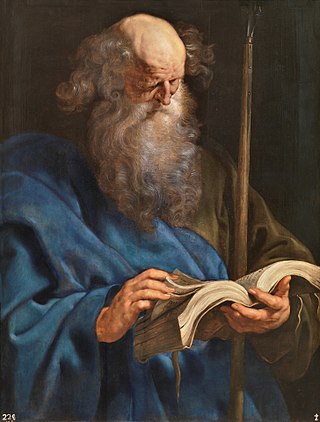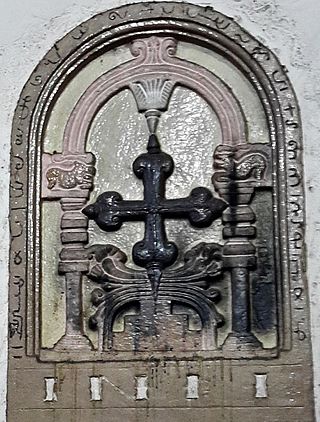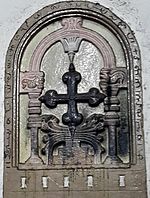
Thomas the Apostle, also known as Didymus, was one of the Twelve Apostles of Jesus according to the New Testament. He is believed to be one of the apostles who was so close from Jesus Christ, that they referred this bond as brotherhood, hence "the brother of Jesus", as was his brother James. His actual name was Judah (Jude) and he was mentioned along with the other brothers of Jesus in the Gospel of Mark 6:1. It is believed he was dubbed the "twin" due to his resemblance to his brother Jesus. Thomas is commonly known as "Doubting Thomas" because he initially doubted the resurrection of Jesus Christ when he was told of it ; he later confessed his faith on feeling the places where the wounds had healed on the holy body of Jesus after the crucifixion.

The Saint Thomas Christians, also called Syrian Christians of India, Marthoma Suriyani Nasrani, Malankara Nasrani, or Nasrani Mappila, are an ethno-religious community of Indian Christians in the state of Kerala, who, for the most part, employ the Eastern and Western liturgical rites of Syriac Christianity. They trace their origins to the evangelistic activity of Thomas the Apostle in the 1st century. The Saint Thomas Christians had been historically a part of the hierarchy of the Church of the East but are now divided into several different Eastern Catholic, Oriental Orthodox, Protestant, and independent bodies, each with their own liturgies and traditions. They are Malayalis and their mother tongue is Malayalam, which is a Dravidian language. Nasrani or Nazarene is a Syriac term for Christians, who were among the first converts to Christianity in the Near East.

Christianity is India's third-largest religion with about 26 million adherents, making up 2.3 percent of the population as of the 2011 census. The written records of Saint Thomas Christians mention that Christianity was introduced to the Indian subcontinent by Thomas the Apostle, who sailed to the Malabar region in 52 AD.

The Synod of Diamper (Udayamperoor Synod) (Malayalam: ഉദയംപേരൂർ സൂനഹദോസ്, romanized: Udayampērūṟ Sūnahadōs), held at Udayamperoor (known as Diamper in non-vernacular sources) in June 1599, was a diocesan synod, or council, that created rules and regulations for the ancient Saint Thomas Christians (also known as Mar Thoma Nasranis) of the Malabar Coast, a part of modern-day Kerala state, India, formally subjugating them and downgrading their whole Metropolitanate of India as the Diocese of Angamale, a suffragan see to the Archdiocese of Goa administered by Latin Church Padroado missionaries. This synod also introduced forced Liturgical Latinisation and the eschewal of local practices and beliefs, leading to a significant ecclesial protest by Saint Thomas Christians known as Coonan Cross Oath and a subsequent schism in the mid-17th century.

The Eparchy of Irinjalakuda-Kodungallur is a suffragan eparchy in the ecclesiastical province of the metropolitan Syro-Malabar Catholic Archeparchy of Thrissur in Kerala state's Thrissur District, southern India.It is part of the Syro-Malabar Church.
Mar Thoma V was the 5th Malankara Metropolitan who served puthenkoor from 1728 to 8 May 1765. He was born as Ousep to the Pallippuram branch of the Pakalomattom family, situated in Andoor, Marangattupilly, where his father served as administration chief of Vadakkumkur Kings. He was ordained in 1728 and served as Malankara Metropolitan for 37 years until his death on May 8, 1765. His final resting place is Niranam St. Mary’s Church. His tenure faced numerous challenges and conflicts with bishops sent from the Syriac Orthodox Patriarchate in Antioch, resulting in some of these Syriac bishops being banished from the country and forced to return.

This article lists the various old and ancient churches that exist among the Saint Thomas Christians in Kerala.

Pesaha appam or Kurisappam is a firm rice cake made by the Christians of Kerala, India, to be served on the night of Maundy Thursday (Pesaha). It is made from rice batter like palappam, but is not fermented with yeast in its preparation. A cross is made using the palm leaves from Palm Sunday, and placed in the middle of the batter.

The Jacobite Syrian Christian Church, or the Syriac Orthodox Church in India, is a Maphrianate of the Syriac Orthodox Church of Antioch based in Kerala, India and part of the Oriental Orthodox Church. It recognizes the Syriac Orthodox patriarch of Antioch and All the East as supreme head of the church. It functions autonomously within the church as an Archdiocese, administered by the Metropolitan Trustee, under the authority of the Maphrian of India, Baselios Thomas I. Following schism with the Malankara Orthodox Syrian Church, it is currently the only church in Malankara that is under the administrative supervision of Syriac Orthodox Church. The church employs the West Syriac Rite Liturgy of Saint James.

The Malankara Church, also known as Puthenkur, is the historic unified body of West Syriac Saint Thomas Christian denominations which claim ultimate origins from the missions of Thomas the Apostle. This community, under the leadership of Thoma I, opposed the Padroado Jesuits as well as the Propaganda Carmelites of the Latin Church, following the historical Coonan Cross Oath of 1653. The Malankara Church's divisions and branchings have resulted in present-day Churches that include the Jacobite Syrian Christian Church, the Malankara Orthodox Syrian Church, the Malankara Mar Thoma Syrian Church, the Malabar Independent Syrian Church, the Syro-Malankara Catholic Church, the Saint Thomas Anglicans of the Church of South India and the St. Thomas Evangelical Church of India.

Christianity is the third-largest practiced religion in Kerala, accounting for 18% of the population according to the 2001 Indian census. According to traditional accounts, Thomas the Apostle sailed to the Malabar region in 52 AD and introduced Christianity to the area. Although a minority, the Christian population of Kerala is proportionally much larger than that of India as a whole. A significant portion of the Indian Christian population resides in the state.

Palayur Mar Thoma Major Archiepiscopal Church, is located at Palayur, in Thrissur district in Kerala on the west coast of India. According to Saint Thomas Christian tradition, the Syrian church was established in 52 AD by St Thomas, one of the twelve apostles of Jesus Christ. Saint Thomas performed the first baptism in India here, therefore this church is called an Apostolic Church credited to the apostolate of St. Thomas, who preached and also introduced Christianity to the people here. It is part of the Ēḻarappaḷḷikaḷ that he established in India, the others being at Cranganore, Kokkamangalam, Kottakkavu, Kollam, Niranam, and Chayal (Nilackal). The original small church structure has been retained at the original site. But substantial improvements around it were carried out during the 17th century by Giacomo Fenicio as necessary, without sacrificing the main sanctity of the place.

Kariattil Mar Iousep, alternatively written as Mar Joseph Kariattil, was the first native Indian to be appointed as Metropolitan of Kodungalloor (Cranganore) for Syrian Catholics in the territory now comprising Kerala, India.

Palliveettil Chandy also known as Parambil Chandy was a bishop of the Catholic Saint Thomas Christians. He is also the first known native Indian bishop.

Most churches in Kerala follow the tradition of Syrian Christians, known as Saint Thomas Christians. The remainder of religious people in Kerala are Latin Catholics, or part of a minority of Protestant Christians.

Champakulam Kalloorkadu St. Mary's Basilica is an ancient Christian Church in Kerala. It belongs to the Syro-Malabar Church under the Archeparchy of Changanacherry. It is a Forane church, with several parishes under it.

The Saint Thomas Christian denominations are Christian denominations from Kerala, India, which traditionally trace their ultimate origins to the evangelistic activity of Thomas the Apostle in the 1st century. They are also known as "Nasranis" as well. The Syriac term "Nasrani" is still used by St. Thomas Christians in Kerala. It is part of the Eastern Christianity institution.

Kottakkavu Mar Thoma Syro-Malabar Pilgrim Church is a Syro-Malabar church located in North Paravur. According to Saint Thomas Christian tradition, the church was established in 52 AD by St. Thomas, one of the twelve apostles of Jesus Christ. It is one of the first churches in India and is called an Apostolic Church credited to the Apostolate of St. Thomas who preached and also started conversion of people to Syriac Christianity here. It is one of the Ezharappallikal that he established in India; the other six churches were established at Kodungalloor, Kokkamangalam, Palayoor, Kollam, Niranam, and Nilackal.
Ēḻarappaḷḷikaḷ or Ezharappallikal, are the seven major churches or Christian communities of Saint Thomas Christians across Malabar Coast of India that are believed to have been founded by Thomas the Apostle in the first century. According to Indian Christian traditions, the apostle Thomas arrived in Muziris (Kodungallur) in AD 52, established the Ezharappallikal and evangelised in present-day Kerala and Tamil Nadu. Many of these churches built near Jewish and Brahmin settlements. These were at Maliankara (Kodungallur), Kollam, Palayoor, Kottakkayal, Kokkamangalam, Niranam and Nilackal (Chayal). Thiruvithamcode church in Kanyakumari was built on the land given by arachan (king) and hence it is often referred in the name Arappally. Similarly, the Churches at Malayattoor and Aruvithura are also referred to as Arappallikal.



















